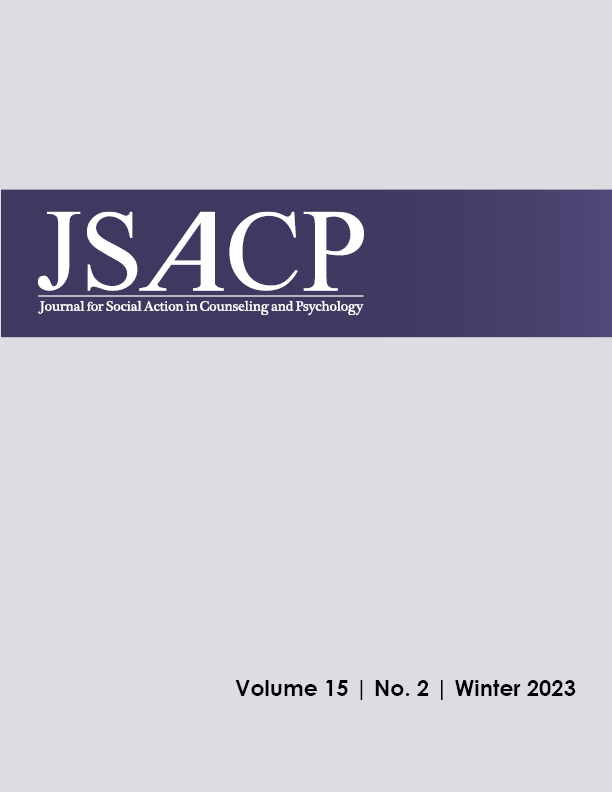"Putting my life into a story"
A Preliminary Evaluation of a Digital Narrative Intervention Combining Participatory Video and Narrative Therapy
DOI:
https://doi.org/10.33043/JSACP.15.2.50-61Keywords:
participatory video, narrative therapy, Latinx youth, immigrants, program evaluationAbstract
This article describes the development, implementation, and evaluation of a digital narrative intervention that combined participatory video (PV) and narrative therapy practices to engage Latinx immigrant young people in processes of personal and societal change. Drawing on ethnographic field notes, process recordings, audio recordings of intervention implementation, and focus group data, this program evaluation offers empirical evidence of the impacts of this innovative, digital narrative intervention on Latinx immigrant young people (ages 18-24) in New Orleans. A constructivist grounded theory approach to data analysis resulted in three main themes: critical reframing, Latinx and immigrant pride, and media literacy. This study unites PV and narrative therapy as complementary approaches to working with marginalized groups to share their stories, suggesting that the combination of these two storytelling practices resulted in several positive outcomes for participants.
Downloads
References
Angus, L. E., & McLeod, J. (2004). The Handbook of Narrative and Psychotherapy: Practice, Theory and Research. SAGE.
Blazek, M. (2017). Participatory video with children and young people. In R. Evans, L. Holt, & T. Skelton (Eds.), Methodological Approaches (pp. 243–260). Springer. https://doi.org/10.1007/978-981-287-020-9_20
Brooks, C. M., & Poudrier, J. (2014). Anti-oppressive visual methodologies: Critical appraisal of cross-cultural research design. Qualitative Sociology Review, 10(4), 32–51. http://www.qualitativesociologyreview.org/ENG/archive_eng.php
Bruner, J. (1991). The Narrative Construction of Reality. Critical Inquiry, 18(1), 1–21.https://doi.org/10.1086/448619
Burkholder, C., & Gube, J. (2018). Exploring racial identities through participatory visual and ethnographic methods: (Re)presenting the identities of ethnic minority youth in Hong Kong. Visual Studies, 33(3), 219–230. https://doi.org/10.1080/1472586X.2018.1527187
Cahill, C., & Bradley, M. (2011). Documenting (in)justice: Community-based participatory research and video. In S. E. Sutton & S. P. Kemp (Eds.), The Paradox of Urban Space: Inequality and Transformation in Marginalized Communities (pp. 223–239). Palgrave Macmillan US. https://doi.org/10.1057/9780230117204_13
Charmaz (2014). Constructing Grounded Theory. SAGE.
Chun Tie, Y., Birks, M., & Francis, K. (2019). Grounded theory research: A design framework for novice researchers. SAGE Open Medicine, 7, 2050312118822927. https://doi.org/10.1177/2050312118822927
Denborough, D. (Ed.). (2006). Trauma: Narrative Responses to Traumatic Experience. Dulwich Centre Publications.
Fernández, J. S. (2021). Growing Up Latinx: Coming of Age in a Time of Contested Citizenship. In Growing Up Latinx. New York University Press. https://doi.org/10.18574/nyu/9781479801244
Flesher Fominaya, C. (2010). Collective identity in social movements: Central concepts and debates. Sociology Compass, 4(6), 393–404. https://doi.org/10.1111/j.1751-9020.2010.00287.x
Foucault, M. (1980). Power/Knowledge: Selected Interviews and Other Writings, 1972-1977 (C. Gordon, Ed.; 1st American Ed edition). Vintage.
Frey, W. H. (2020, July 1). The nation is diversifying even faster than predicted, according to new census data. Brookings. https://www.brookings.edu/research/new-census-data-shows-the-nation-is-diversifying-even-faster-than-predicted/
Frey, W. H. (2021, February 26). The demographic case for investing in America’s children. Brookings. https://www.brookings.edu/research/the-demographic-case-for-investing-in-americas-children/
Friesem, E. (2014). A story of conflict and collaboration: Media literacy, video production and disadvantaged youth. Journal of Media Literacy Education, 6(1). https://digitalcommons.uri.edu/jmle/vol6/iss1/4
Hagen, P., Collin, P., Metcalf, A., Nicholas, M., Rahilly, K., & Swainston, N. (2012). Participatory design of evidence-based online youth mental health promotion, intervention and treatment. http://pandora.nla.gov.au/pan/141862/20160405-1343/www.youngandwellcrc.org.au/wp-content/uploads/2014/03/Young_and_Well_CRC_IM_PD_Guide.pdf
Huber, L. P., & Cueva, B. M. (2012). Chicana/Latina testimonios on effects and responses to microaggressions. Equity & Excellence in Education, 45(3), 392–410. https://doi.org/10.1080/10665684.2012.698193
Lilly, J.M. (2023). The AltaVoces Project: A Digital Narrative Approach to Anti-Oppressive Social Work Research with Latino Youth. Qualitative Social Work, 22(3), 465-483. https://doi.org/10.1177/14733250211070590
Luttrell, W. (2012). Making boys’ care worlds visible. Boyhood Studies, 6(2), 186–202. https://doi.org/10.3149/thy.0601.186
Miller Scarnato, J. (2018). Media Production as Therapy: A Systematic Review. Journal of Technology in Human Services, 36(4), 241-273. https://doi.org/10.1080/15228835.2018.1539368
Miller Scarnato, J. (2019). Making Connections: A Reflection on Narrative Group Work with Latinx Youth. Social Work with Groups, 43(1-2), 80-85. https://doi.org/10.1080/01609513.2019.1638634
Milne, E.-J., Mitchell, C., & Lange, N. de. (2012). Handbook of Participatory Video. AltaMira Press.
Nemtin, B., & Low, C. (1968). Fogo Island Film and Community Development Project (p. 34). National Film Board of Canada. http://onf-nfb.gc.ca/medias/download/documents/pdf/1968-Fogo-Island-Project-Low-Nemtin.pdf
Neuhauser, L. (2017). Integrating participatory design and health literacy to improve research and interventions. Information Services & Use, 37(2), 153–176. https://doi.org/10.3233/ISU-170829
Ruby, J. (2000). Picturing Culture: Explorations of Film and Anthropology. University of Chicago Press.
Sawyer, S. M., Afifi, R. A., Bearinger, L. H., Blakemore, S.-J., Dick, B., Ezeh, A. C., & Patton, G. C. (2012). Adolescence: A foundation for future health. The Lancet, 379(9826), 1630–1640. https://doi.org/10.1016/S0140-6736(12)60072-5
Scharrer, E., & Ramasubramanian, S. (2015). Intervening in the media’s influence on stereotypes of race and ethnicity: The role of media literacy education. Journal of Social Issues, 71(1), 171–185. https://doi.org/10.1111/josi.12103
Soep, E. (2012). The digital afterlife of youth-made media: Implications for media literacy education. Comunicar, 19(38), 93–100.
Suarez-Orozco, M., & Paez, M. (Eds.). (2008). Latinos: Remaking America (First Edition, Updated with a New Preface). University of California Press.
Šupšáková, B. (2016). Media education of children and youth as a path to media literacy. Communication Today, 7(1), 32–51.
Torres, V., & Hernandez, E. (2007). The influence of ethnic identity on self-authorship: A longitudinal study of Latino/a college students. Journal of College Student Development, 48(5), 558–573. https://doi.org/10.1353/csd.2007.0057
White, M. K. (2007). Maps of Narrative Practice. W. W. Norton & Company.
Yager-Elorriaga, D., Berenson, K., & McWhirter, P. (2014). Hope, ethnic pride, and academic achievement: Positive psychology and Latino youth. Psychology, 5(10). https://doi.org/10.4236/psych.2014.510133
Downloads
Published
How to Cite
Issue
Section
License
Copyright (c) 2024 Jenn Lilly

This work is licensed under a Creative Commons Attribution-NonCommercial-NoDerivatives 4.0 International License.
By submitting to JSACP, the author(s) agree to the terms of the Author Agreement. Beginning in 2018, all authors retain copyrights associated with their article contributions and agree to make such contributions available under a Creative Commons Attribution-NonCommercial-NoDerivatives 4.0 International license upon publication in JSACP. Copyrights to articles published prior to 2018 have been transferred from the authors to JSACP.









